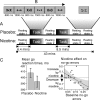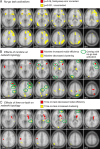Human brain functional network changes associated with enhanced and impaired attentional task performance
- PMID: 23554472
- PMCID: PMC6618923
- DOI: 10.1523/JNEUROSCI.4854-12.2013
Human brain functional network changes associated with enhanced and impaired attentional task performance
Abstract
How is the cognitive performance of the human brain related to its topological and spatial organization as a complex network embedded in anatomical space? To address this question, we used nicotine replacement and duration of attentionally demanding task performance (time-on-task), as experimental factors expected, respectively, to enhance and impair cognitive function. We measured resting-state fMRI data, performance and brain activation on a go/no-go task demanding sustained attention, and subjective fatigue in n = 18 healthy, briefly abstinent, cigarette smokers scanned repeatedly in a placebo-controlled, crossover design. We tested the main effects of drug (placebo vs Nicorette gum) and time-on-task on behavioral performance and brain functional network metrics measured in binary graphs of 477 regional nodes (efficiency, measure of integrative topology; clustering, a measure of segregated topology; and the Euclidean physical distance between connected nodes, a proxy marker of wiring cost). Nicotine enhanced attentional task performance behaviorally and increased efficiency, decreased clustering, and increased connection distance of brain networks. Greater behavioral benefits of nicotine were correlated with stronger drug effects on integrative and distributed network configuration and with greater frequency of cigarette smoking. Greater time-on-task had opposite effects: it impaired attentional accuracy, decreased efficiency, increased clustering, and decreased connection distance of networks. These results are consistent with hypothetical predictions that superior cognitive performance should be supported by more efficient, integrated (high capacity) brain network topology at greater connection distance (high cost). They also demonstrate that brain network analysis can provide novel and theoretically principled pharmacodynamic biomarkers of pro-cognitive drug effects in humans.
Figures






Similar articles
-
Nicotine dependence (trait) and acute nicotinic stimulation (state) modulate attention but not inhibitory control: converging fMRI evidence from Go-Nogo and Flanker tasks.Neuropsychopharmacology. 2020 Apr;45(5):857-865. doi: 10.1038/s41386-020-0623-1. Epub 2020 Jan 29. Neuropsychopharmacology. 2020. PMID: 31995811 Free PMC article.
-
Nicotine enhances but does not normalize visual sustained attention and the associated brain network in schizophrenia.Schizophr Bull. 2011 Mar;37(2):416-25. doi: 10.1093/schbul/sbp089. Epub 2009 Aug 27. Schizophr Bull. 2011. PMID: 19713300 Free PMC article. Clinical Trial.
-
Nicotine replacement in abstinent smokers improves cognitive withdrawal symptoms with modulation of resting brain network dynamics.Neuroimage. 2010 Aug 15;52(2):590-9. doi: 10.1016/j.neuroimage.2010.04.251. Epub 2010 May 2. Neuroimage. 2010. PMID: 20441798 Clinical Trial.
-
Direction and magnitude of nicotine effects on the fMRI BOLD response are related to nicotine effects on behavioral performance.Psychopharmacology (Berl). 2011 May;215(2):333-44. doi: 10.1007/s00213-010-2145-8. Epub 2011 Jan 18. Psychopharmacology (Berl). 2011. PMID: 21243486 Free PMC article. Clinical Trial.
-
Functional brain imaging of nicotinic effects on higher cognitive processes.Biochem Pharmacol. 2011 Oct 15;82(8):943-51. doi: 10.1016/j.bcp.2011.06.008. Epub 2011 Jun 13. Biochem Pharmacol. 2011. PMID: 21684262 Free PMC article. Review.
Cited by
-
Resting-State Functional Connectivity of the Basal Nucleus of Meynert in Cigarette Smokers: Dependence Level and Gender Differences.Nicotine Tob Res. 2017 Apr 1;19(4):452-459. doi: 10.1093/ntr/ntw209. Nicotine Tob Res. 2017. PMID: 27613921 Free PMC article.
-
Incidental and intentional learning of verbal episodic material differentially modifies functional brain networks.PLoS One. 2013 Nov 18;8(11):e80273. doi: 10.1371/journal.pone.0080273. eCollection 2013. PLoS One. 2013. PMID: 24260362 Free PMC article.
-
Modular reconfiguration of an auditory control brain network supports adaptive listening behavior.Proc Natl Acad Sci U S A. 2019 Jan 8;116(2):660-669. doi: 10.1073/pnas.1815321116. Epub 2018 Dec 26. Proc Natl Acad Sci U S A. 2019. PMID: 30587584 Free PMC article. Clinical Trial.
-
The evolution of cost-efficiency in neural networks during recovery from traumatic brain injury.PLoS One. 2017 Apr 19;12(4):e0170541. doi: 10.1371/journal.pone.0170541. eCollection 2017. PLoS One. 2017. PMID: 28422992 Free PMC article.
-
Persistency and flexibility of complex brain networks underlie dual-task interference.Hum Brain Mapp. 2015 Sep;36(9):3542-62. doi: 10.1002/hbm.22861. Epub 2015 Jun 12. Hum Brain Mapp. 2015. PMID: 26095953 Free PMC article.
References
-
- Baars BJ. A cognitive theory of consciousness. New York: Cambridge UP; 1988.
-
- Baars BJ. The conscious access hypothesis: origins and recent evidence. Trends Cogn Sci. 2002;6:47–52. - PubMed
Publication types
MeSH terms
Substances
Grants and funding
LinkOut - more resources
Full Text Sources
Other Literature Sources
